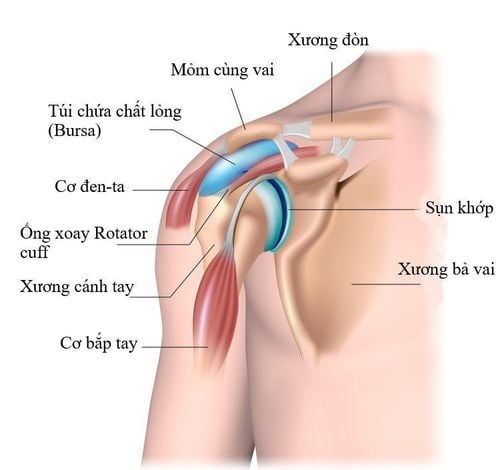This is an automatically translated article.
The article was professionally consulted by Specialist Doctor I Nguyen Thanh Hai - Radiologist - Department of Diagnostic Imaging and Nuclear Medicine - Vinmec Times City International General Hospital. Doctor Hai has more than 20 years of experience in the field of diagnostic imaging, especially in the field of multi-slice computed tomography, magnetic resonance.Osteoarthritis related to the shoulder area is becoming more and more common. In the past, contrast-enhanced shoulder scintigraphy was the preferred means of diagnosis. However, at present, non-invasive imaging techniques are increasingly being developed, including shoulder ultrasound technique, which not only supports the examination and diagnosis process but also is used by doctors. for indications in the treatment of some diseases
1. What is shoulder joint?
The shoulder joint plays an important role in performing flexible movements in most body activities. However, the shoulder joint is very susceptible to injury due to many different reasons.The shoulder joint is a large joint, made up of many different parts of bones, muscles and ligaments in the shoulder and arm area. The main function is to coordinate movements in daily activities next to other joints in the body.
Structure of the shoulder joint includes the following components:
Bone part:
The humerus is the largest bony component of the shoulder joint. Constructed with a rounded bone head for easy connection and rotation in the concave part of the shoulder blade. The shoulder blades are triangular in shape, connecting the collarbone and arm bones to the front parts of the body. The collarbone is a small bone that extends from the front of the sternum to the scapula of the shoulder blade. The collarbone helps stabilize the movements of the shoulder joint. Ligament:
Brachial cruciate ligament: This is the strongest ligament of the shoulder joint. The attachment point of this ligament is from the cranium of the scapula and divides into two, attaching to the large and small tubercles of the humerus. Lumbar-brachial ligament: The ligament that travels from the socket to the humerus, divides into three parts, superior, inferior, and medial, surrounding the shoulder joint. The scapula-cranium ligament: A series of fibers connecting the apex of the shoulder and the crow's process, forming the arch of the sacral process. This is the large ligament that can be seen on ultrasound images of the shoulder joint.

2. What is an ultrasound of the shoulder joint?
Shoulder joint ultrasound is a non-invasive imaging technique that effectively supports the investigation of a number of shoulder-related injuries. This technique typically uses a high frequency linear transducer (7.5 - 12 MHz).The shoulder joint ultrasound technique is performed in the patient's sitting position with the back straight and changed according to the doctor's examination requirements during the ultrasound.
Requirements when doing shoulder ultrasound are: Comprehensive examination of both shoulders, starting with the side with little or no symptoms and usually divided into 3 areas for ultrasound: the anterior, middle, and posterior regions.
Some images that can be recorded on ultrasound of the shoulder joint and suggest the diagnosis include:
Normal shoulder ultrasound image: Including the rotator cuff tendons and the outside of the rotator cuff (such as the biceps tendon, supraspinatus and subspinal tendons, subscapular tendons, minor rotator cuff tendons), joints and ligaments. Biceps tendon: The patient is seated, the hand is placed supine on the thigh. The image of the biceps tendon on ultrasound of the shoulder joint is oval in cross section, located in the biceps groove and has small echogenic parts inside (it's essentially fibrous tissue). In contrast, when ultrasonography is in the longitudinal section, the biceps tendons are thick echogenic sections running parallel to each other. If the patient has signs of painful swelling in the anterior midbrain, it may suggest a rupture of the biceps tendon. On ultrasonography of the shoulder joint, if the long end of the tendon is severed, fluid surrounds the tear and thickens echoes at the tear site. Other biceps tendon abnormalities on shoulder ultrasound include biceps tendonitis, biceps tendonitis, or subluxation of the biceps tendon. Tendons on the spine: can see the image of tendonitis, rupture, and tear. Dislocation: The image on ultrasound of the shoulder joint is that the humeral head is displaced in or out of the joint socket. Ultrasound of the shoulder joint can also record some other abnormal signs such as: synovial injury, fluid accumulation in the joint sockets, foreign bodies in the shoulder joint, deformations or abnormal structures around the shoulder joint...
3. What is the use of shoulder ultrasound?
Ultrasound of the shoulder joint, in addition to the function of recording injuries, suggesting the diagnosis of the disease, also has the ability to support the effective treatment of a number of other bone and joint diseases.Some injuries or arthritis conditions after being diagnosed will be supported and treated through ultrasound of the shoulder joint. Bursitis, bursitis, and tendonitis are diseases supported by ultrasound guidance.
Shoulder ultrasound is considered a safe and effective imaging tool to quickly assess conditions related to the shoulder joint as well as contribute to the treatment of these conditions.
The advantage of ultrasound is to help detect diseases early and limit serious complications later. However, ultrasound of the shoulder joint requires a doctor to have expertise and experience, understand the anatomy of the shoulder joint to detect abnormalities if present on ultrasound.

In addition, the hospital not only ensures professional quality with a team of leading medical doctors, modern equipment and technology, but also stands out for its comprehensive and specialized medical examination, consultation and treatment services. Karma; civilized, polite, safe and sterile medical examination and treatment space.
For detailed information, please contact the hospitals and clinics of Vinmec health system nationwide.
Please dial HOTLINE for more information or register for an appointment HERE. Download MyVinmec app to make appointments faster and to manage your bookings easily.
SEE ALSOHow does ultrasound help identify knee osteoarthritis? Common shoulder joint diseases How to deal with shoulder injury?














